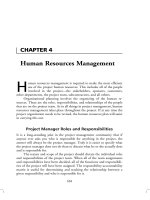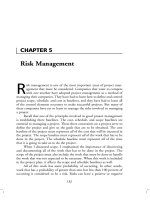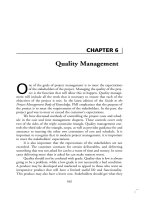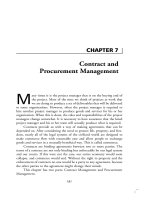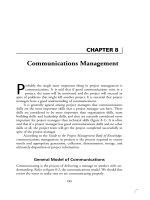Tài liệu Project Management Professional-Chapter 10 docx
Bạn đang xem bản rút gọn của tài liệu. Xem và tải ngay bản đầy đủ của tài liệu tại đây (135.07 KB, 14 trang )
CHAPTER 10
What Is the PMP Exam Like?
T
he Project Management Institute (PMI) has constantly improved the
PMP examination since it was first given and will continue to improve
the exam as time goes on. April 2002 was significant because of the
culmination of several factors that have had an influence on the PMP exami-
nation. The Project Management Professional (PMP) Role Delineation Study
was begun in 1999 to help define the roles and responsibilities of project
management professionals. From this knowledge, an examination could be
designed that would truly test the prospective candidates and prove that the
candidates for certification could indeed competently practice the profession
of project manager. A good and content-valid examination for project man-
agement professionals cannot be developed unless the roles of project manag-
ers and how they are practiced are clearly understood.
In order to accomplish this, PMI hired a company experienced in these
things, Columbia Assessment Services (CAS). The initial development and
evaluation was completed by a panel of thirteen members considered to be
subject matter experts in the field of project management. These members
represented a variety of fields of practice, industries, geographic locations,
and, of course, both genders. This panel determined that there would be six
project management domains:
• Initiating
• Planning
• Executing
• Controlling
218
219What Is the PMP Exam Like?
Table 10-1. Evaluation of domains.
Domain Percent of Test Number of Questions
Initiating 8.5% 17
Planning 23.5% 47
Executing 23.5% 47
Controlling 23% 46
Closing 7% 14
Professional responsibility 14.5% 29
• Closing
• Professional Responsibility
From each of the domains, a number of tasks were created, and for
each of these tasks, the knowledge and skills required were determined. Once
this was done project managers were surveyed from various age groups, edu-
cation levels, industries, regions of the world, levels of experience, and earn-
ing levels.
In the survey, the managers were asked to evaluate the importance of
the six domains on a scale of 1 to 5. The domains were evaluated according
to importance, criticality, and frequency of use. The survey results were then
used to determine the number of questions in each of the domain areas that
would be in the examination. The results are shown in table 10-1.
Domain 1: Initiating the Project
Initiating has ten tasks associated with it. The PMP exam will have seventeen
questions from domain 1.
Tasks:
1. Two questions. ‘‘Determine project goals by identifying and work-
ing with project stakeholders in order to meet their requirements,
specifications and/or expectations.’’
2. Two questions. ‘‘Determine product or service deliverables by re-
viewing or generating the scope of work, requirements, and/or
specifications to meet the stakeholder expectations.’’
3. One question. ‘‘Determine project management process outputs
9618$$ CH10 09-06-02 15:00:05 PS
220 Preparing for the Project Management Professional Certification Exam
by applying appropriate practices, tools, and methodologies to en-
sure required product/service delivery.’’
4. One question. ‘‘Document project constraints through coordina-
tion with stakeholders and review of policies and procedures to
ensure compliance.’’
5. Two questions. ‘‘Document assumptions by determining informa-
tion that must be validated or situations to be controlled during
the project in order to facilitate the project planning process.’’
6. One question. ‘‘Define the project strategy by evaluating alterna-
tive approaches to meet stakeholder requirements, specifications,
and/or expectations.’’
7. Two questions. ‘‘Identify performance criteria by referring to prod-
uct/service specifications and process standards in order to ensure
and/or support the quality assurance effort.’’
8. Two questions. ‘‘Determine key resource requirements by referring
to deliverables in order to support planning and decision-making.’’
9. Two questions. ‘‘Define an appropriate project budget and sched-
ule by determining time and cost estimates in order to support
decision-making.’’
10. Two questions. ‘‘Provide comprehensive information by producing
a formal document to obtain an approval decision from the stake-
holders.’’
Domain 2: Planning the Project
Planning has seven tasks associated with it. The PMP exam will have forty-
seven questions from domain 2.
Tasks:
1. Eight questions. ‘‘Refine project requirements, assumptions, and
constraints through communication with stakeholders and/or by
reviewing project documents to baseline the scope of work and
enable development of the execution plan.’’
2. Seven questions. ‘‘Create the Work Breakdown Structure using the
scope of work, other project documents, and decomposition tech-
niques to facilitate detailed project planning and the executing,
controlling, and closing process.’’
9618$$ CH10 09-06-02 15:00:06 PS
221What Is the PMP Exam Like?
3. Six questions. ‘‘Develop the resource management plan (Human
Resources, Procurement, etc.) by identifying resource requirements
and obtaining commitments from internal, external, and procured
sources to complete all project activities.’’
4. Six questions. ‘‘Refine project time and cost estimates by applying
estimating tools and techniques to all WBS tasks in order to deter-
mine project baseline, schedule, and budget.’’
5. Six questions. ‘‘Establish project controls by defining the required
correct processes, measures and controls to manage project change,
communications, procurement, risk, quality, and human resources
to facilitate project executing and controlling processes, and to en-
sure compliance with generally accepted industry standards.’’
6. Seven questions. ‘‘Develop a formal and comprehensive project
plan by integrating and documenting project deliverables, accep-
tance criteria, processes, procedures, risks and tasks to facilitate
project executing, controlling and closing processes.’’
7. Seven questions. ‘‘Obtain project plan approval by reviewing the
plan with the client and other required stakeholders to confirm
project baselines prior to proceeding with project executing proc-
esses.’’
Domain 3: Executing the Project
Executing has five tasks associated with it. The PMP exam will have forty-
seven questions from domain 3.
Tasks:
1. Ten questions. ‘‘Commit project resources in accordance with the
project plan to ensure that all activities are performed.’’
2. Nine questions. ‘‘Implement the project plan by authorizing the
execution of project activities and tasks to produce project delivera-
bles.’’
3. Eleven questions. ‘‘Manage project progress by ensuring that activ-
ities are executed as planned in order to achieve the project objec-
tives.’’
4. Nine questions. ‘‘Communicate project progress by producing
9618$$ CH10 09-06-02 15:00:06 PS
222 Preparing for the Project Management Professional Certification Exam
project reports to provide timely and accurate project status and
decision support information to stakeholders.’’
5. Eight questions. ‘‘Implement quality assurance procedures by per-
forming project control activities to meet project objectives.’’
Domain 4: Controlling the Project
Controlling has eight tasks associated with it. The PMP exam will have
forty-six questions from domain 4.
Tasks:
1. Seven questions. ‘‘Measure project performance continually by
comparing results to the baseline in order to identify project trends
and variances.’’
2. Four questions. ‘‘Refine control limits on performance measures by
applying established policy in order to identify needs for corrective
action.’’
3. Seven questions. ‘‘Take timely corrective action by addressing the
root causes in the problem areas in order to eliminate or minimize
negative impact.’’
4. Five questions. ‘‘Evaluate the effectiveness of the corrective actions
by measuring the subsequent performance in order to determine
the need for further actions.’’
5. Seven questions. ‘‘Ensure compliance with the change manage-
ment plan by monitoring response to change initiatives in order to
manage scope.’’
6. Four questions. ‘‘Reassess project control plans by scheduling peri-
odic reviews in order to ensure their effectiveness and currency.’’
7. Six questions. ‘‘Respond to risk event triggers in accordance with
the risk management plan in order to properly manage project
outcomes.’’
8. Six questions. ‘‘Monitor project activity by performing periodic
inspections to ensure that authorized approaches and processes are
followed or to identify the need for corrective action.’’
Domain 5: Closing the Project
Closing has five tasks associated with it. The PMP exam will have fourteen
questions from domain 5.
9618$$ CH10 09-06-02 15:00:06 PS
TEAMFLY
Team-Fly
®
223What Is the PMP Exam Like?
Tasks:
1. Four questions. ‘‘Obtain final acceptance of deliverables by obtain-
ing formal approval from appropriate stakeholders to achieve
closeout.’’
2. Two questions. ‘‘Document lessons learned by surveying project
team members and other relevant stakeholders to use for the bene-
fit of future projects.’’
3. Three questions. ‘‘Facilitate administrative and financial closure in
accordance with the project plan in order to comply with organiza-
tion and stakeholder requirements.’’
4. Three questions. ‘‘Preserve essential project records and required
tools by archiving them for future use to adhere to legal and other
requirements.’’
5. Two questions. ‘‘Release project resources by following appropriate
organizational procedures in order to optimize resource utiliza-
tion.’’
Domain 6: Professional Responsibility
Professional responsibility has five tasks associated with it. The PMP exam
will have twenty-nine questions from domain 6.
Tasks:
1. Eight questions. ‘‘Ensure individual integrity and professionalism
by adhering to legal requirements and ethical standards in order to
protect community and all stakeholders.’’
2. Three questions. ‘‘Contributing to the project management knowl-
edge base by sharing lessons learned, best practices, research, etc.
within appropriate communities in order to improve the quality of
project management services, build capabilities of colleagues, and
advance the profession.’’
3. Five questions. ‘‘Enhance individual competence by increasing and
applying knowledge to improve services.’’
4. Five questions. ‘‘Balance stakeholders’ interests by recommending
approaches that strive for fair resolution in order to satisfy compet-
ing needs and objectives.’’
9618$$ CH10 09-06-02 15:00:07 PS
224 Preparing for the Project Management Professional Certification Exam
5. Eight questions. ‘‘Interact with team and stakeholders in a profes-
sional and cooperative manner by respecting personal, ethnic, and
cultural differences in order to ensure a collaborative project man-
agement environment.’’
Types of Questions on the Exam
All of the questions on the PMP exam are multiple choice. There are only
four choices for each question, and there are two hundred questions. This
means that you will only have an average of 1.2 minutes per question. This
is not a lot of time, but it is usually enough if English is your native language,
that is. Otherwise, you may have some problems with the timing of the
exam.
The best approach to the exam is to go through it rapidly, answering
all of the questions that you are certain about. I can remember doing this on
the old PMP exam and realizing that at the end of the process I was not sure
of any of the answers. When you are done with those, go back and answer
the questions that you skipped. This will take advantage of any information
that you can learn as a result of answering the questions you know. If you
definitely know the answer to a question, then you also know that the other
answers are wrong for that question. This information may allow you to
answer a question that you skipped earlier. Be sure to answer every question
on the exam. There is no subtraction for wrong answers. Only the right
answers are counted.
The trend in the PMP examination is to use questions that are ‘‘situa-
tional’’ in nature. This means that the questions will be more like the word
problems you had in your high school math classes. These are the kind that
go something like this: If Joe has four apples and Sally has three oranges,
what time will the train from Chicago meet the train from New York? This
is thought to test the candidate PMP more thoroughly in the competence of
project management and less in the area of rote memorization. This has been
accomplished. While the other project management organizations around
the world may be critical of PMI not using the interview methods that so
many other organizations favor, PMI has achieved the recognition of the
International Standards Association, ISO 9000: 2000 certification for the
process of certifying PMPs. This means that the process that PMI uses does
what it is supposed to do, and it does act to select project management
professionals from those who are not qualified.
9618$$ CH10 09-06-02 15:00:07 PS
225What Is the PMP Exam Like?
PMI uses the Angoff modified technique for constructing the ques-
tions. This means that a large number of PMPs are used in the process.
First, PMPs are trained to write questions for the exam. These questions are
reviewed by committees of PMPs and finally are given to an independent
professional who reviews the questions again for construction and ambiguity.
Once the questions are reviewed, they are submitted to another group
of PMPs who are asked to rate the questions in terms of whether they think
a question tests a person seeking the PMP certification who is ‘‘minimally
qualified.’’ Each question is evaluated this way.
Although there is a passing grade for the exam, it is not going to neces-
sarily be the same from year to year. PMI rates the difficulty of each question
on the exam. A mixture of questions of varying difficulty are then selected
so that the difficulty of each version of the exam is about the same. Each
question on the exam is given to a group of PMPs who are asked the ques-
tion, ‘‘What is the probability that a minimally acceptable candidate will
answer this question correctly?’’ The probabilities are summarized, and each
question receives a difficulty rating. So, if you take the exam with one set of
questions and then take it again a year later with a different set of questions,
the difficulty rating for the whole exam should be about the same, even
though you have a different set of questions. The passing grade for each
exam should be about the same as well, but this is not necessarily the case.
The questions fall into three categories. ‘‘Recall questions’’ are similar
to what most of the questions on the PMP exam used to be like. These
questions give you a definition and then different items, one of which is the
item whose definition was stated. The ‘‘application questions’’ ask you to
pick out what a project manager should do under the situation described.
The ‘‘analysis questions’’ require you to take the information offered and,
by looking at the relationships between the various pieces of information,
come up with the correct answer.
You can expect that for most of the questions two of the four answers
are easily discarded, and the remaining two will often be difficult to separate
into the right and wrong answer.
Taking the Exam
The first thing you must do is get a good night’s sleep the night before the
exam. Don’t eat a lot of sugar the morning of the exam. Eat a good breakfast.
Try to do things in the way that you do them every day. If you are used to
drinking coffee, then do not deprive yourself on the day of the exam.
9618$$ CH10 09-06-02 15:00:08 PS
226 Preparing for the Project Management Professional Certification Exam
Get there in plenty of time to take the exam. If you are using public
transportation, be sure to allow for waiting time for the bus or train. If you
are driving, be sure to allow enough time for traffic delays. You want to be
there with enough time to calm yourself and prepare mentally for what will
be a tough four hours. A very good friend of mine was totally relaxed about
the exam. In fact, she was so relaxed that she forgot to go take it. The proctor
phoned her an hour after the exam started and told her that she had not
shown up for the exam. She decided to take the exam and rushed over to
the exam site. Unfortunately, the proctor could not stay, and she had to take
the exam in two-and-a-half hours instead of four. She passed. But not every-
one can do that. Better to be there early, relax, go over your critical notes,
and take the exam in a relaxed manner.
There is a fifteen minute tutorial before the exam, and there will be
some papers to sign. This activity is not counted as exam time. Take the
time to go through the tutorial. It will stop you from making mistakes with
the computer that could lose you valuable time in the exam. The four-hour
exam time is just the time for answering questions on the exam.
You are allowed one break during the exam. This break can be up to
one hour in length, and the timing of the exam will stop for the break. Once
you are back at the exam work station, the exam time will continue until the
four hours have been completed or you have finished the exam. When you
are finished, the proctor will grade your exam, and you will be told whether
you have passed or not.
My suggestion for remembering formulae and such if you are having
trouble memorizing is to bring the formulae to the exam written on a card.
Before the exam, look over the card and leave it outside the examination
room. You do not want someone to see you inside the room with something
like that. When you get into the exam room, recall the formulae and write
them on the approval scrap paper. This is a good idea if you are a person
who has trouble memorizing things and when under pressure gets signs and
the order of variables mixed up.
Use of Practice Questions
In the last section of the book I have included nearly three hundred practice
questions. Each of these is answered, and the answers are annotated. The
questions should give you a good idea of what the exam will be like. I suggest
taking several questions from each section and trying to answer them in the
same amount of time PMI will give you, that is, 1.2 minutes per question.
9618$$ CH10 09-06-02 15:00:08 PS
227What Is the PMP Exam Like?
Alternatively, you can take several of the questions and answer them
after reviewing each of the chapters in the book on the subject of the ques-
tions. The questions are organized by the Guide to the PMBOK knowledge
areas plus another section for the professional responsibility questions. I did
not mix the questions as they will be on the actual examination, because I
thought it would be more helpful to be able to review at least some of the
questions at the end of each chapter. The questions on the actual exam that
you will take will be randomized; if you have just answered a question from
the planning domain about scheduling, the next question may be from any
other knowledge area or project management domain.
Many people think that the best way to pass the PMP exam is to prac-
tice on the questions from various sources. This has two major problems.
One is that the questions that you are likely to get your hands on are ques-
tions that someone other than PMI made up. These questions will certainly
not have the rigorous inspection that PMI has given the questions on the
actual exam. Security around the exam is very tight. None of the questions
that are actually on the exam are likely to come into your hands. Prior to
the changes in the exam effective April 2002 many of the questions on the
exam were one-line type questions. Many of the practice questions you will
see are mostly of this type. Practicing them for the exam will not help you
when you take the actual exam. You will find that the questions on the actual
exam are longer and require you to do quite a bit of analysis and answer the
question, ‘‘What would a project manager do in this situation?’’
The second and most important thing is that practicing on the exam
questions will not give you a good knowledge of project management. It will
give you only knowledge of the questions you practice with. PMI has gone
to extreme lengths to make the exam something that will separate project
management professionals from those who are not. This it does very well. It
does it well enough that the certification process is itself confined by the
International Standards Organization, ISO 9000; 2000. The exam tests your
real knowledge and professionalism. I feel that it actually does a good job of
testing your competence as well.
The practice questions are a good way to test your knowledge, but I do
not think that they are the only way. A solid understanding of the principles
and methods of project management is extremely important to passing the
PMP exam. The use of practice questions gives you some idea about the
style and form of the questions, and this is something you need to know.
Using the questions as the principle way of preparing for the exam is a
serious mistake and will generally earn you a failing grade.
9618$$ CH10 09-06-02 15:00:09 PS
228 Preparing for the Project Management Professional Certification Exam
The Application for PMP Certification
I will not go into all six pages of the application form. Most of it is straight-
forward except for the experience section and possibly the education section.
For experience you are required to have 4,500 hours of project management
experience over the last six years. The same process applies for those who do
not have a bachelor’s degree or equivalent from a university, only the num-
ber of years is increased to eight and the number of hours is increased to
7,500. There is, of course, some confusion for people from countries other
than the United States. PMI has included in the application a list of the
equivalent degrees that are issued by various countries. If your country is not
listed, then you should contact PMI and ask about the validity of the degree
that you have earned.
As part of the experience requirements, the number of nonoverlapping
months of experience must be thirty-six for those with a bachelor’s degree
and sixty months without it. This requirement needs some explanation.
Let’s take our applicant with the bachelor’s degree. The requirement is
for thirty-six months experience over the last six years. During this time you
must have accumulated 4,500 hours of experience. The easiest way to see if
you qualify is to make a bar chart listing the projects you worked on over
the last six years. Show each project bar starting and ending in the month
that is started and ended. Of the seventy-two months in your bar chart at
least thirty-six of them should have one or more projects occupying the
month. If you go from one end of the time scale to the other, and you can
count more than thirty-six months where there is a project that you worked
on, you are qualified. Do not count a month more than once. That is, if you
worked on two projects at the same time in a given month, you can count
the month only one time.
For example, our candidate works on a project from June to November
2002 and works on another project from August to December 2002. He can
count June, July, August, September, October, November, and December
for a total of seven months of experience. August, September, October, and
November should not be counted two times even though two projects were
being worked on at that time.
Be careful that the hours of experience you claim matches the start and
finish dates of the projects they come from. Do not say you worked on a
project for three months and claim 1,000 hours. Even the best of us would
have trouble accumulating 1,000 hours of experience in thirteen weeks, so
be careful not to do this. It should be perfectly clear to the PMI reviewer
that the experience you claim is indeed matched to the projects.
9618$$ CH10 09-06-02 15:00:09 PS
229What Is the PMP Exam Like?
PMI also requires that you separate the experience into the project
management process areas. There is really no requirement for this, and you
could have all your experience in the project execution area and still qualify.
I don’t know why PMI requires you to separate your experience hours into
the process areas, but as long as they do, you should separate them as in-
structed. Be careful that the totals also equal the number of hours that you
have put on the other pages.
If you fill out the experience sheets of the application carefully, your
application should be accepted. By no means should you lie on the applica-
tion. If you do not have enough experience, then you will have to wait to
get your PMP certification.
The last sheet for each project is an explanation of your experience on
the project. You should list the deliverables that you were responsible for on
the project in some detail. One page should be sufficient for each project.
Be sure that the deliverables that you are explaining match the type and
hours of experience that you have put on the previous page.
This is the only section of the application that is tedious. You must fill
out two sheets minimum for each project you worked on. For some of you
this could be a lot of projects. Take the time and be careful. Put yourself in
the mind of the reviewer. Make the whole application consistent, and be sure
that all the hours add up to the same totals. Make sure that your narrative on
each project matches and supports the number of hours you are claiming in
each domain.
The Education Qualification
There is now a requirement that you receive thirty-five contact hours of
project management education. This requirement is relatively simple to
achieve. These can be classes that you take at a university; they can be courses
taught by training companies or consultants; they can be courses from a
registered education provider or any PMI component (chapter). They can
even be courses offered by your own company or distance learning courses.
This is a pretty broad classification. The timing of the education has no
limits, so you can claim the hours going back in time as far as you wish.
The following is PMI’s checklist for the PMP application:
• Name on application matches name on ID (two required)
• Payment or payment information
9618$$ CH10 09-06-02 15:00:09 PS
230 Preparing for the Project Management Professional Certification Exam
• Experience verification goes back more than three years
• Experience verification does not go back more than six years
• Experience verification includes more than 4,500 hours involved with
project management
• Experience verification includes thirty-six months total
• Deliverables from each project are summarized
• There are thirty-five hours of documented project management in-
struction
Joining PMI
Today the cost of joining PMI and becoming a PMP are very close to the
same as becoming a PMP without joining PMI. The benefits of joining PMI
are tremendous for the money. Beside being able to network with other PMI
members and having the many publications that will be delivered to you,
you will be part of an organization of project management practitioners that
has grown to nearly 100,000 worldwide.
Here is a list of just a few of the benefits that come to you as a PMI
member:
• Discount on many items
• PMI Knowledge and Wisdom Center
• Project management publications
• PM Network—monthly
• Project Management Journal—quarterly
• PMI Today—monthly
• PMI book store
• Networking
• PMI conferences
• Specific interest groups
• PMI chapters
• Career hotline for job searches
Recertification
To be qualified for recertification you must accumulate sixty professional
development units (PDUs) over a three-year period. A PDU is equivalent to
one hour of contact time in a class on project management offered by a
9618$$ CH10 09-06-02 15:00:10 PS
231What Is the PMP Exam Like?
registered education provider. There are also many other ways to acquire
PDUs. The different ways of acquiring PDUs will take too much space to
review here, but after you have acquired your PMP certification you will
have three years or more to accumulate these PDUs. You are able to earn
PDUs for attending classes, writing a book or an article on project manage-
ment, presenting a paper on project management, and many other items
outlined in the professional development section of PMI’s Web site at www
pmi.org. The timing of the three years starts on January 1 of the January
following your certification, so the first time you requalify, you may really
have more than three years’ time to accumulate enough PDUs.
9618$$ CH10 09-06-02 15:00:10 PS




